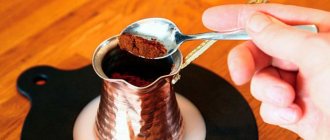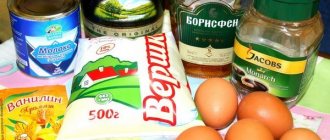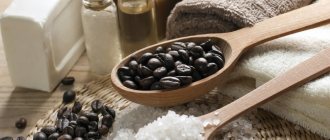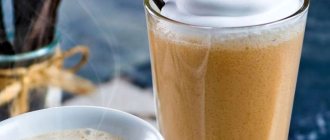What kind of foam do you miss in your coffee? There are two types of foam, and in order not to torment you with a verbal load, we give out the information right away.
1. The brown foam that forms on the surface of coffee (espresso) is called “ creama” .
2. White foam , milk using steam. Used in cappuccino and latte drinks.
Why does foam appear on coffee?
The creation of the cream is a mixture of several different things: as the water is forced through the coffee under pressure, it breaks down the oil in the beans, sealing it in tiny micro-bubbles of air. Additionally, once coffee is roasted, gas is released over a period of time (usually for the next 24 to 72 hours after roasting), so coffee that has been freshly roasted will also release some CO2 during extraction.
Not only does the foam serve as a lid for the coffee underneath, securely trapping the precious aromatic components that make the drink even more delicious, but it also contains important gases - in fact, more than the liquid itself.
Essentially, creams are a mixture of oils, sugars and proteins that form a network of tiny spheres. Each bottle contains valuable sensory information - much more information per cubic milliliter than coffee.
Other ways to get foam in your coffee
Delicious coffee made in a French press or pour over is good for everyone, but lacks foam. Of course, you can decorate the drink with whipped milk or cream, but there are more original ways to make coffee with foam:
- whip up the foam from instant coffee;
- prepare foam from whipped yolks.
Instant coffee foam
Black coffee according to an arbitrary recipe is prepared in a regular geyser coffee maker, French press or pour over. While the drink is infusing, beat 1 sticker or 1 teaspoon of instant coffee with sugar and water to stiff peaks using the method described above. Then carefully transfer the foam onto the surface of the coffee with a spoon. This amount of foam is enough to decorate 50–60 g of natural black coffee. The foam is stable and you can draw latte art on it.
Why is the role of cream so important and is it really so?
As the coffee industry focuses more and more on quality, distribution, craft and taste, crema used to be a differentiator for two different things:
- Firstly, it showed the content of natural oils in the beans and, therefore, it could be assumed that they were processed in the correct way on the plantation.
- Second, the crema demonstrated that the coffee had been roasted recently enough that there was still CO2 emitted from the beans.
Baristas and coffee professionals often consider crema to be the most important element of a good espresso. This is not necessarily true. You can make a beautiful, delicious looking coffee that actually tastes quite sour, and conversely, you can brew a batch that has no cream at all due to how the beans were processed on the plantation and how dark the batch was roasted.
Portafilters in pressurized and superautomatic coffee machines have technology that aerates the coffee during extraction, creating the illusion of cream, but the aroma and taste are not guaranteed.
Serbian coffee
In Serbia, the worst shame for a housewife is the inability to make coffee with foam. Here the foam is called “kaymak” (the same as thick cream). To prepare Serbian coffee, the beans are ground only into dust, the proportions are the same as for Turkish coffee (in Turk).
Recipe:
- Pour water into the Turk and put it on fire.
- As soon as the first bubbles appear, remove the Turk from the heat; do not allow it to boil.
- Pour coffee into the water (and sugar if necessary), stir for 5-10 seconds.
- Place the Turk on low heat.
- When the foam rises, turn off the burner.
- Pour the coffee into heated cups in several batches, so that the foam gets into each one.
Due to differences in the preparation method, Serbian coffee is just as aromatic, but less bitter, than Turkish coffee.
What determines the appearance of crema in espresso?
Here are some parameters that affect the appearance of such beautiful coffee foam:
- Processing of grains. Coffee beans that have been dry-processed, honey-processed, semi-husked, or straight into the skin will naturally retain more sugar and fat, resulting in increased cream production during extraction.
- Plantations. Dry processing is usually carried out on plantations in Africa and Brazil, and has recently expanded to other plantations in Central and South America. Grains from a humid climate (such as Sumatra) will have a very different flavor and oil content because they are most often wet processed.
- Duration of roasting. The grain needs to lie down and breathe so that CO2 is released to emulsify the oil, but not for too long. Usually you need to wait at least 72 hours, but on average, the aroma and taste are best revealed on 10-14 days.
- Roast color. Darker roast levels release oils to the surface more quickly, and they then remain on the packaging equipment, in the packet, in the grinder, etc., resulting in less oil on the bean itself. So quite often a darker roast means less crema.
- Coffee machine. All these new technologies of double or enhanced extraction, guarantee of golden crema, etc. mean that special aeration technologies are used. Often found in double bottom portfilters, with a taste improver, as well as in vending machines.
You shouldn't just worry about achieving the perfect crema on your coffee just because you think it's right. Only if it really tastes better to you.
Bialetti Brikka - how to brew coffee with foam in a geyser coffee maker?
Most Bialetti geyser coffee makers have approximately the same design; their differences lie rather in the design and materials used. For example, the classic octagonal Moka Express is an aluminum coffee maker that Bialetti has produced unchanged since 1933. More modern models of cylindrical Bialetti geyser coffee makers are made of steel. The most famous of them are Venus and Musa. However, the principle of making coffee is the same for all these coffee makers.
But there is a model in the Bialetti collection that is worth talking about separately. This is Bialetti Brikka , designed for brewing espresso with foam. It looks similar to classic aluminum geysers, but has one significant difference - an additional valve. This valve covers the outlet for the finished drink and thus increases the pressure inside the device. Under the influence of hot steam, everyone's favorite lush crema appears on the coffee.
In addition to the espresso valve, Brikka has several other differences:
- The water level mark has been moved to the upper container for convenience.
- The lid of the coffee maker has a round window through which it is convenient to observe the brewing process.
- The walls of the coffee maker are slightly thicker than other models, since the pressure inside the lower chamber will be higher due to the valve.
- The coffee does not pour out in a slow stream, as in a regular Moka Express, but accumulates and bursts out from under the valve in 2-3 seconds.
How to brew coffee in Bialetti Brikka
To always get dense, long-lasting foam, you should learn how to use a Brikka coffee maker correctly. There is nothing complicated here, you just need to follow the manufacturer’s recommendations very carefully.
1. Prepare ground coffee for the geyser coffee maker.
If you do not have special ground coffee for geyser coffee makers, focus on medium grinding, i.e. coarser than for espresso machines, but finer than for a French press or drip coffee maker. Properly ground coffee should feel like fine salt to the touch. Of course, the coffee must be fresh.
2. Prepare clean cold water.
It is better to use filtered or bottled coffee, as water affects the taste of the finished coffee. All foreign tastes will mix with the taste of coffee and irreparably spoil it.
3. Carefully measure the amount of water needed.
To do this, use the top container with a special mark. Be sure to fill the water exactly at the level, otherwise the safety valve may become clogged or there will be too much water at the top and your Brikka will stop working properly. Pour the water into the lower container.
4. Install the filter basket and fill it with ground coffee
The coffee does not need to be compacted. You can lightly tap the side of the basket to get rid of any air pockets. Use a knife to remove the “slide” if it appears. Make sure that there are no coffee crumbs left on the threads.
5. Assemble the coffee maker and place it on the stove
The size of the burner must correspond to the diameter of the bottom. Brew coffee on medium to low heat. As soon as you hear the characteristic pop and hiss, the coffee is ready. Pour it into a cup and enjoy the lush foam and rich taste!
Is the coffee from Bialetti Brikka different from the coffee from the classic Moka Express?
It is clear that with the Brikka you are unlikely to get the same coffee as from a 15 bar espresso machine. However, the resulting drink will be much closer in taste and appearance to professionally prepared coffee than it was brewed in a classic geyser coffee maker.
Main differences:
- The foam in Brikka is more abundant, thick and persistent. You can see this for yourself by looking at the photographs.
- The coffee is stronger. This is also obvious, since the drink is prepared at higher pressure, which means that more flavoring substances and caffeine enter the water. If you are used to brewing coffee in a Turk or French press, then coffee from Brick may seem unusually strong to you.
- The taste is rich, rich, full-bodied. Afterwards, coffee from the classic Bialetti Moka Express coffee maker may seem watery, bitter and overcooked.
Pros and cons of coffee cream
If the drink was brewed correctly, the beans were medium roasted, a good coffee machine was used and everything was in order with the espresso taste - the crema will only give it more charm and a longer aftertaste. Here's a quick description of what espresso crema is:
- This is a good indicator of the freshness of your coffee beans.
- This tells you what kind of roast was used (light or dark).
- It makes coffee taste better when done correctly.
But foam doesn't always mean your coffee will taste great. The cream has no particular disadvantages, but sometimes it disguises a not-so-best drink prepared automatically.
Cezve: the right material is the main condition for obtaining foam
Coffee prepared in a special cezve is no longer just a drink. It turns from ordinary into exquisite, capable of captivating with its aroma and forever making you fall in love with its taste and aftertaste.
In the distant past, concubines, sultans, kings and emperors in different parts of the world pampered themselves with coffee brewed in a cezve. Poems and poems were written about this drink, it inspired the geniuses of yesteryear, and continues to evoke a storm of emotions among modern gourmets.
So, cezva is the same Turk. It happens:
- ceramic;
- clay;
- metal.
You can brew coffee in a Turk with foam from any material, but the most reliable is copper. It is the copper cezve that is the most durable and suitable for preparing an aromatic and tasty drink at home. Copper heats up well and does not cool down for a long time, maintaining the temperature of the contents. High-quality copper pot - with environmentally friendly coating inside.
A clay pot is a great environmentally friendly option. The downside of the product is the specific taste with which the clay imbues the drink. However, it’s all about choosing the cezve manufacturer. If this product is made of Chinese Yixing clay, then foreign odors will not be absorbed into the coffee, since the material allows air to pass through, enriching the liquid with it, allowing the bouquet of taste and aroma to fully reveal itself.
You can only cook coffee in a clay pot at home, not forgetting the property of the material to absorb odors.
A universal option is a ceramic Turk. Of all three, it is the most fragile and can become unusable even with a sharp change in temperature. Compared to metal and clay cezves, ceramic is the most expensive and requires special care. But everyone can make coffee with foam in such a Turk the first time, and this is a significant advantage.
You may be interested in Basic methods of making coffee - barista secrets
Brewing features and how to tell if your crema is good
The espresso preparation time to ensure the ideal extraction time is a maximum of 25 to 35 seconds. The crema should form a few seconds after the brewing process begins, and then the drink is poured through it.
- Dark colored foam often indicates a blend made from Robusta coffee beans.
- The golden color of the crema comes from a blend of high-quality Arabica beans.
For espresso, a mixture of Arabica and Robusta is usually used, since Arabica gives a brighter taste and aroma, and Robusta gives just that crema and the desired density. It is desirable that the thickness of the cream be at least 2 mm, aerobatics - up to 4 mm.
- If the color is too light and the bubbles are few and large, then your espresso is unfinished. It may be worth increasing the brewing time, since the drink itself may be weaker and more liquid in consistency.
- On the other hand, darker crema may be the result of over-extraction or the use of a darker roast (which also produces less crema). Excessive brewing process can make the drink overly bitter and burnt.
Many baristas believe that a good foam on coffee should last for at least a minute, not separate at the edges, and, if prepared perfectly, should also be able to withstand a spoonful of sugar without letting it fall. After drinking, a dark chocolate rim should remain on the walls.
In any case, the main thing is that you like the drink. Achieving the perfect cream is already a professional art, and if you are confident in the quality of the beans, but the foam just doesn’t come out, buy a coffee machine with “improvers” in the filter. In coffee shops they usually cook on the right equipment, and there is already cream there - this is really an indicator of proper brewing.
Conclusions:
- The foam on the coffee is called crema, the emphasis is on the last syllable.
- More often than not, cream is an indicator of a properly prepared drink, but much depends on the beans, processing method and other factors.
- There are coffee machines that enhance the cream, so the drink will definitely be beautiful, but the taste is already a subjective concept.
- A good cream is dense, smooth, 2-4 mm high, lasts about a minute without spreading.
- The main thing is to decide on the taste of the coffee, and you can always make foam at home using the right equipment so that it is as beautiful as possible.











